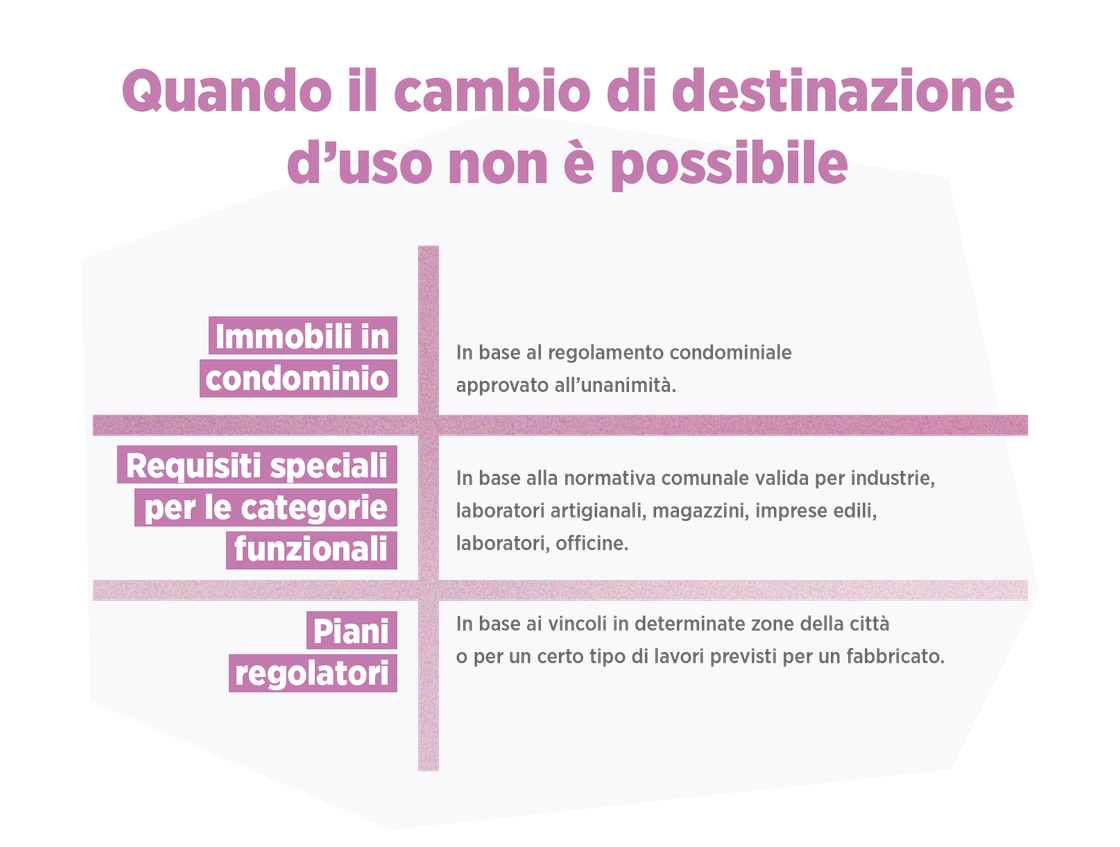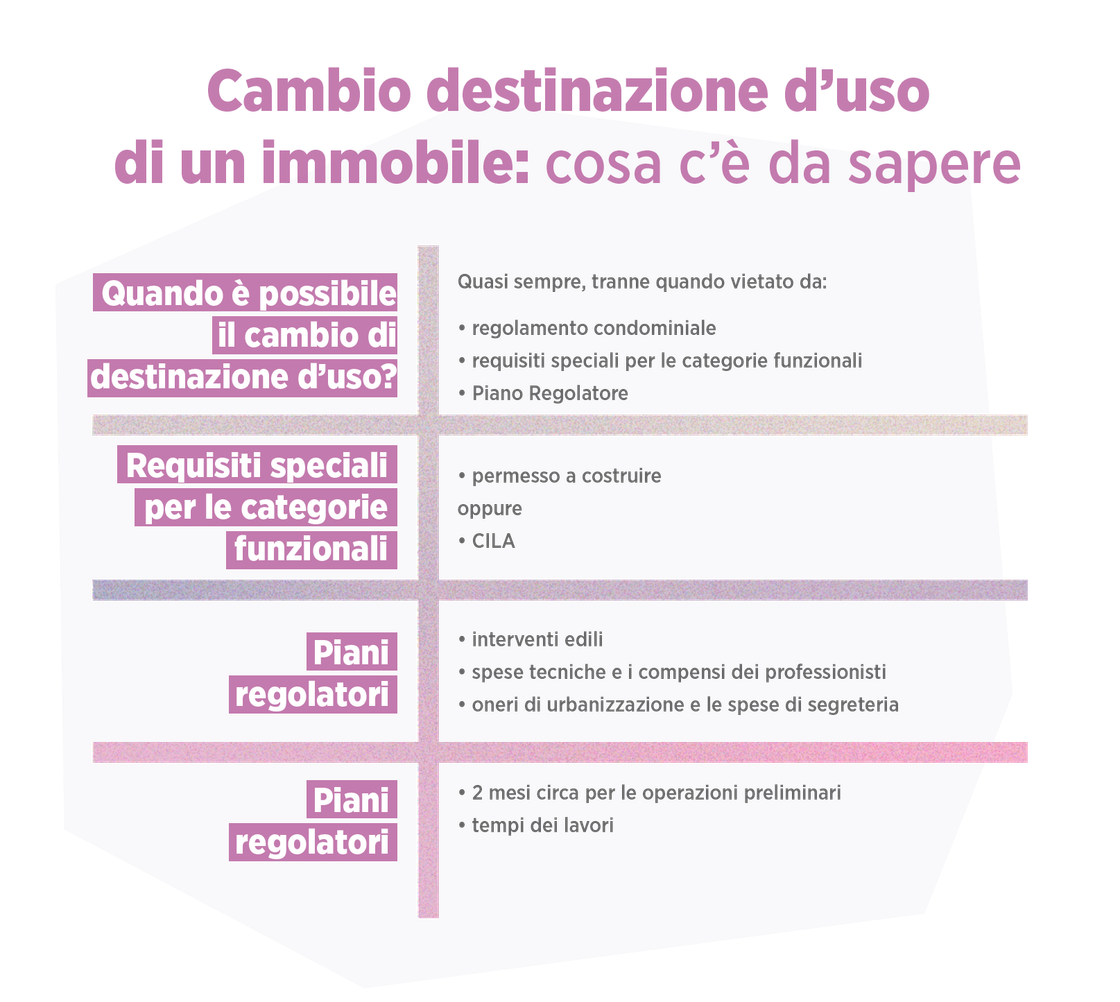Index
To change the use of a property from an office to a home, you need: a formal application, a floor plan, urban planning and habitability certificates, and payment of municipal taxes.

If you are trying to understand how to change the intended use of a property, we have good news for you: you have just found The guide you've been looking for, with all the information you need.
After browsing dozens of listings, you've finally fallen for a property that seems perfect for you: the size is just right, the exposure guarantees light at all hours, and the location in the city is strategic, away from the chaos of the center but without being over the top. It has everything you're looking for in your dream home, but... wow, the description says it's a professional studio. Do you think it's enough to redecorate and arrange the interior spaces with a few renovations? Unfortunately, no, it's not enough.
To transform the studio into your new home, you will also need to change its intended use from office to home, and you will need to do the same if you want to convert it into a warehouse or a shop.
The change of use is a simple procedure that, however, requires a lot of attention to detail. To help you with the procedure, documents and costs for the property you have decided to buy, we have collected all the information you need in this practical guide to changing the intended use.
What we talk about in this article
- What does it mean? the intended use of a property
- What are the intended uses?
- When è Is it possible to change the intended use?
- What documents are needed to change the intended use
- Intended use: costs, timescales and procedures to follow
What is the intended use of a property?
Let's start with the definitions. In Italian law, the intended use indicates the function that is recognized for a building or a single real estate unit. To explain in simpler terms, every building has a purpose within society, both from an urban planning and cadastral perspective: to accommodate the people who live there or to host industrial or commercial production activities, such as shops and artisan workshops.
As mentioned earlier, with the change of intended use you can transfer any property from one category to another. In the next paragraph we will see what the main categories provided for by the law are, but for now we will focus on the concept of urbanistically relevant change.
According to Article 23-ter of the Consolidated Law on Construction (as amended in 2014 by the so-called Sblocca Italia Decree) - and unless otherwise provided for by regional regulations - the change of use is considered urbanistically relevant when it involves the transition from one category to another, even without building works. This is the case, for example, of the change of intended use from residential to commercial premises. Why is it considered relevant? Because the change also has effects on the calculation of the cadastral income and on the definition of taxes to be paid such as IMU and TASI, which vary depending on the group to which the property belongs.
What are the intended uses?
Properties are therefore divided into groups based on the function they fulfill in the social context. The intended uses are many and try to cover the widest possible range of situations. In addition to the office and home that we have already seen, the most Common ones are shops, commercial premises, warehouses, storerooms and garages.
The functional categories envisaged for the destination of properties vary according to regional regulations, but in general we can collect them within the six large groups that you see in the table below with the relative specifications:
Intended use Type of property Residential This includes homes of any type and nature, including bed and breakfast services and professional offices in the event that the prevalent size of the unit is 100 square meters. be used for residential purposes. Industrial and artisanal This group includes industries, artisanal workshops, warehouses, construction companies, laboratories, and workshops. Generally, all activities are included in this category. aimed at the production or transformation of goods, materials or services. Commercial Includes retail stores, large-scale wholesale distribution services, markets, but also bars, restaurants, cafes, pubs and other similar services. Tourist accommodation Includes hotels, campsites and hostels. Management or service the category that includes banks, insurance companies, management offices, private offices, and professional studios. Agricultural Here we have properties intended for agricultural production, livestock farming, and related services, as well as nurseries, woods, pastures, rural homes, greenhouses, and even agritourism.
Let's look at some concrete examples.
If you decide to designate a room in the house for your professional studio or your artisan workshop, you won't need to follow any procedure. In this case, in fact, the property is In all respects, your home and its main function in terms of size is that of a dwelling.
If, however, you have purchased a residential property to make a shop where you can sell your creations, you will have to change its intended use from home to commercial premises.
Are there any limits to transforming any property according to your needs? The answer is in the next paragraph.
When is it possible to change the intended use?
In general, it is always possible to obtain the change from one intended use category to another. However, there are There are some exceptions determined by law or by some local regulations. Here are which ones.
1. Condominium properties
Let's start with the more specific ones that concern condominium properties. If, for example, you intend to convert a warehouse into an apartment, before requesting a change of use from warehouse to residence, you would be best to consult the condominium regulations and verify that there are no restrictions for new housing units. The ban on change, however, is valid only if the regulations have been approved unanimously by the condominium owners: otherwise, it cannot place limits on individual rooms.
2. Special requirements for functional categories
The law provides some requirements tailored to the different functional categories. Just think of the mandatory chimney for all premises that serve cooked food. There are also indications for the minimum surface areas of the various rooms of the housing units (for example, the bathroom cannot be less than 3.5 m2 in homes), and for the so-called air-lighting ratios which indicate the proportion between the dimensions of the windows and those of the various rooms. These rules vary from municipality to municipality.
Let's make a hypothesis: you want to buy a shop located on the ground floor of a building and then transform it into a residence through a change of intended use? Before proceeding with the sale, carefully inform yourself about the regulatory provisions of your city, to avoid unpleasant surprises that could thwart your plans.
3. Regulatory Plans
Finally, pay attention to the city's General Regulatory Plan (PRG) (or Structural Plan and Urban Planning Regulation, depending on the municipality), which in some cases places restrictions on the change of intended use of a property in certain areas of the city, such as residential neighborhoods. Not only that: the PRG can also limit the type of work planned for a building.
A common case concerns buildings in the historic city center with maintenance restrictions that impose only simple maintenance work. In this case, even in the absence of a specific prohibition on changing the category, you will still be limited by the type of work you can carry out.
In addition to these regulatory limitations, there are others to consider regarding the structure of the building. In general, all systems (electrical, water, sewerage) must be compliant, and the property must be able to meet the specific requirements of the functional category to which you intend to assign it. We saw earlier the obligation for restaurants to have a chimney, but beyond that, of the law, make sure that it is really possible to install one in your premises.

What documents are required for the change of intended use?
Now that you know how to determine whether your property meets the conditions for the change, let's look at all the documents needed and who they are requested from. The change from one intended use category to another is always considered a building renovation intervention, even if only simple works are required or even none are required at all. This means that in any case, before proceeding, you will need the building permit issued by the municipality where the property is located.
The DL Semplificazioni 2020, however, has made it more difficult to obtain a building permit. rapid bureaucratic procedures for transitions within the same category. This means that if you are about to change the intended use from a warehouse to a garage, or from a warehouse to a shop, you will not need a building permit, but you will only need the CILA, the certified Communication of Start of Works, to be presented to the technical office of the municipality where the building is located, as we have already seen in our guide to renovating your home.
Now that we have a clearer idea, let's take a look at the options available. Once the documentation is clear, we have one last issue to address regarding the change of intended use: costs.
Intended use: costs, timescales and procedures to follow
Precisely determining the cost of changing from one functional category to another depends on a series of variables that change significantly depending on where the property is located and the type of work you have in mind.
In any case, the main expense items are three:
- the building works needed to make the property suitable for the new category, such as bringing the systems up to standard or installing our chimney, plus those relating to general renovation;
- the technical costs and the fees of the professionals involved in the change, such as architects and real estate lawyers, as well as the costs for managing the works and for safety on the building site;
- the urbanization charges and secretarial costs which vary from municipality to municipality.
Furthermore, the type of change of category you intend to make significantly influences the final price. In the case of a change of use from office to home, the costs will generally be lower than transforming a shop into a pizzeria.
To start a change of use procedure, start by contacting a professional to assist you with the property documents. He will verify the urban planning compliance of the building, that is, the absence of building violations and the necessary hygiene and health requirements. He will then prepare the actual intervention project and at that point he will fill out the building permit.
Generally these preliminary operations require a couple of months, especially to find the property documents in the municipal archives.
The professional will also help you understand if one or more of the conditions that prevent the change of category are present, such as a provision in the condominium regulations or the PRG, or structural limitations. Once everything is ready, you can submit the request to the municipal technical office. At this point, you only need to consider the time required for the work, which obviously depends on the type of work you have planned.
As you can see, changing the category of a property can hide some pitfalls that you should pay attention to. In general, however, it is not a complex procedure; in fact, it is frequently used for the most varied situations, such as:
- the change of intended use from warehouse to garage;
- the change of intended use from shop to residence;
- the change of intended use from residence to commercial premises;
- the change of intended use from warehouse to residence;
- the change of intended use from industrial to commercial;
- the change of intended use from residence to office and vice versa;
- the change of intended use from warehouse to shop.
To recap, take a look at the diagram below.

Whatever project you have in mind, on our platform ads you'll find the property that's right for you in Bologna, Florence, Milan, Rome, Turin, or Verona. Start building your future with Casavo now!

